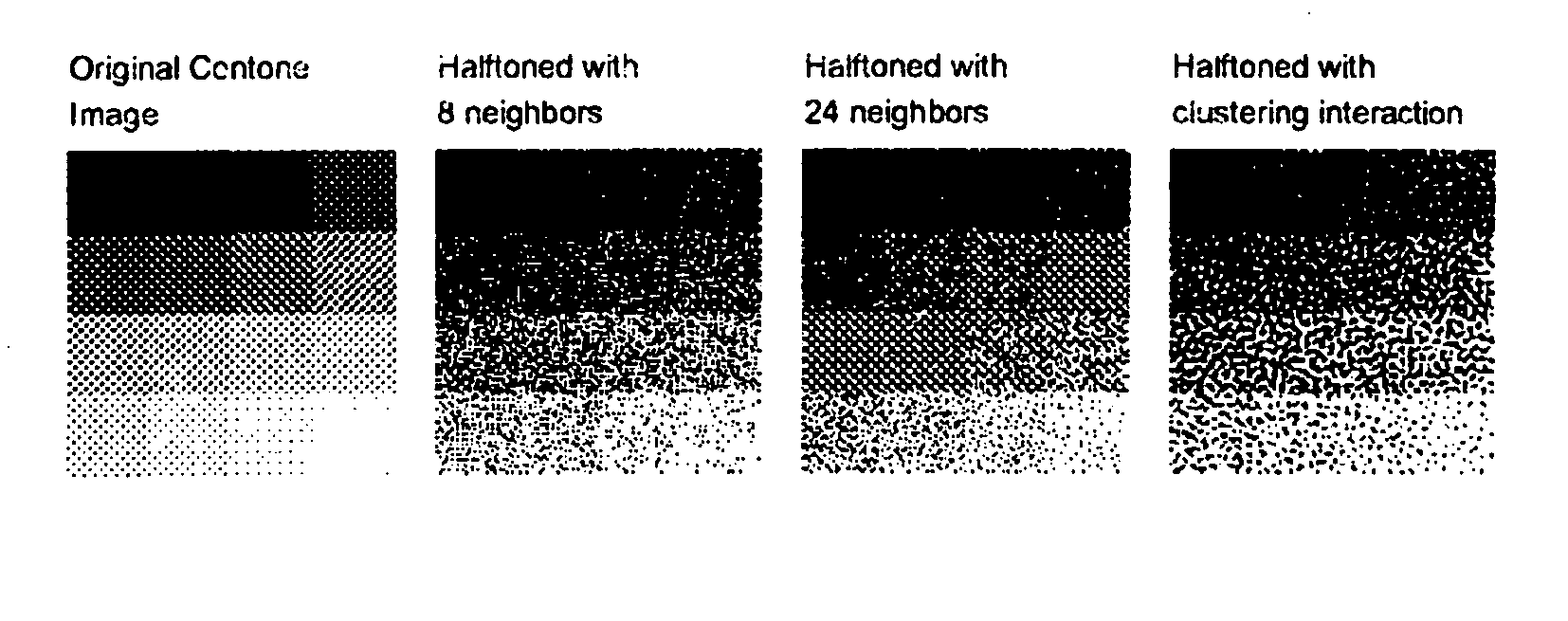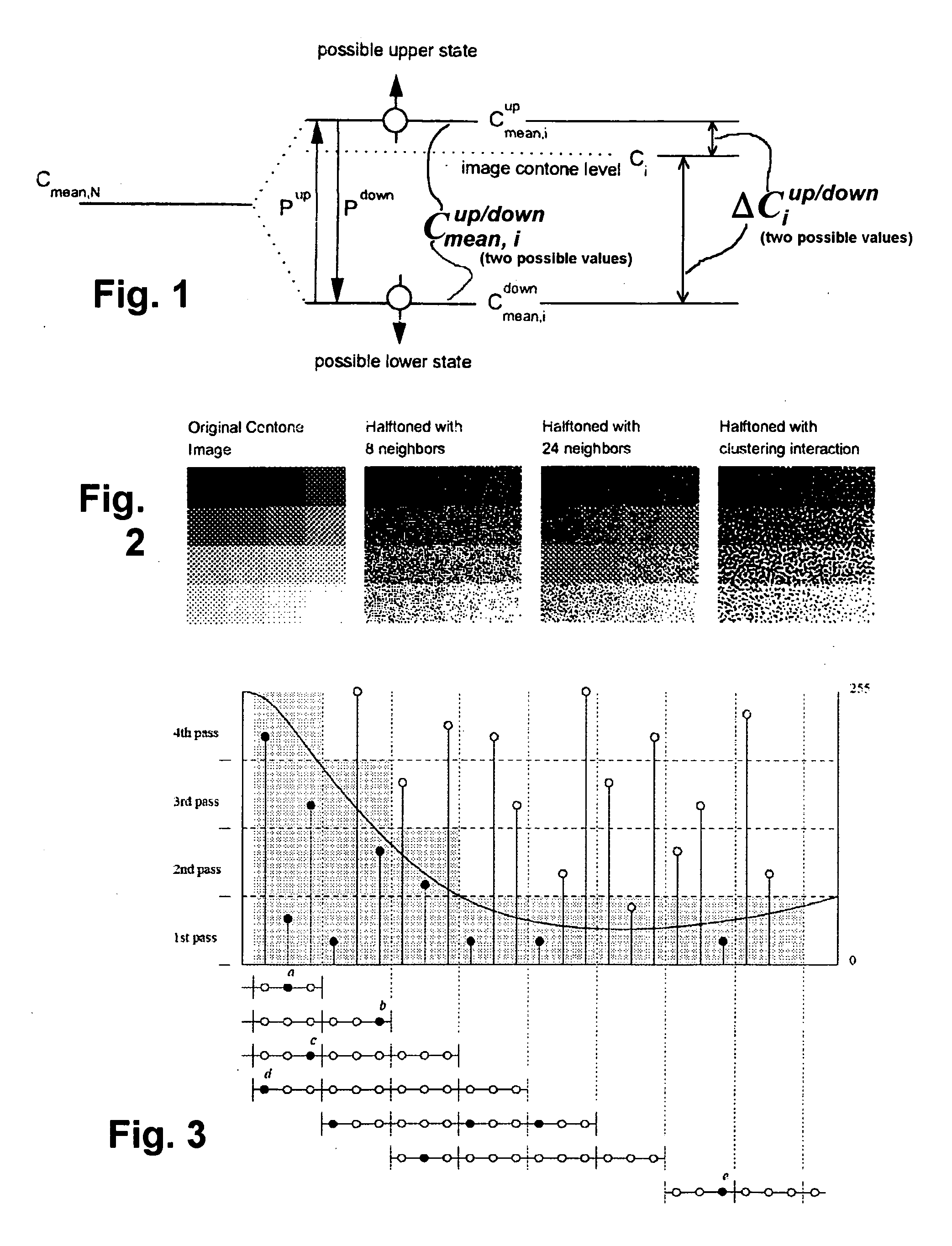This pattern in turn can beat against other periodic structures—such as printmasks, or periodicities in the image data themselves—to generate very conspicuous and undesirable moiré or like patterns.
Error diffusion, however, also operates by producing dispersed dots—which suffer from start-up delays, extremely directional structures that are sometimes said to appear “wormy” or “
crawling”, and also an excessive line smudging.
This latter drawback is especially objectionable on high-resolution devices and in
line drawings.
The directional patterning is particularly conspicuous and objectionable in midtone regions.
It also implies, however, that even higher levels of earlier-distributed error residuals are flowing in the data array, unrelieved by use in a printout.
Although such variants are likely to be far more computation-intensive than standard (directional)
error diffusion, this drawback need not be fatal—especially not in the context of highest-quality imaging requirements.
Some efforts in that direction, while admirable, have not yet completely achieved the goal.
Specifically, the Dillinger / Best constraints make a major improvement in color accuracy by preventing dots of certain colors from printing where those colors are entirely foreign or irrelevant—but do not prevent such dots from printing where the response is merely very disproportionate but not completely irrelevant.
Dillinger and Best offer no mitigation of the directionality problems.
The random-walk suggestions of Balser and the others, conversely, may represent a major improvement in non-directionality, and the resulting patterns—but again fail to address the application of color dots that are irrelevant or disproportionate.
It has perhaps never been proposed to combine the teachings of these references with those of Best and Dillinger; but even if they were combined there would remain no resolution of the disproportionate response to remote error sources.
Yet another drawback—perhaps not well recognized—of known rendition methods is that properties of the final output image as rendered, in particular the quality and fidelity of the image as it will be printed, may not be assessed, or not assessed adequately, in performing the rendition.
As a result the process may produce
image quality that does not adequately repay the investment in rendering, either because excess time is spent in the process or because the image is poor—or both.
Still another drawback is that conventional rendering programs, which require relatively high storage capacity, ordinarily make no contribution to the following downstream stage of printing makeready—namely printmasking.
In other words the storage is used inefficiently.
Again another drawback in some or all conventional rendering is that the process steps are not readily made to take into account the local properties of the input image—for instance its local gray areas and gradients.
The resulting image is therefore not fine-tuned for those local properties, or here too the
processing may require more computing power or more time than fundamentally necessary.
A similar observation applies to handling of interactions between the image data and the rendering, especially some interactions that can cause clustering (graininess in the image) and other undesirable effects.
In addition, some conventional rendering processes that are useful in single-bit binary printing may become quite unwieldy when applied to multilevel printing (e.g. marking systems that use two- or three-bit colorimetric data depth).
Doing so, however, requires subsequent removal of the water base—by
evaporation (and, for some printing media, absorption)—and this
drying step can be unduly
time consuming.
In addition, if a large amount of ink is put down all at substantially the same time, within each section of an image, related adverse bulk-colorant effects arise: so-called “bleed” of one color into another (particularly noticeable at color boundaries that should be sharp), “blocking” or offset of colorant in one printed image onto the back of an adjacent sheet with consequent sticking of the two sheets together (or of one sheet to pieces of the apparatus or to slipcovers used to protect the imaged sheet), and “cockle” or puckering of the printing medium.
Heating, however, has limitations of its own; and in turn creates other difficulties due to heat-induced deformation of the printing medium.
Accordingly, heating has provided only limited improvement of
drying characteristics for these plastic media.
As to paper, the application of heat and ink causes dimensional changes that affect the quality of the image or graphic.
Preheating, however, causes loss of
moisture content and
resultant shrinking of the paper fibers.
To maintain the paper dimensions under these circumstances the paper is held in tension, and this in turn leads to still other dimensional complications and problems.
For example, some printmodes such as square or rectangular
checkerboard-like patterns tend to create objectionable moiré effects—just as noted earlier for
dither masks—when frequencies or
harmonics generated within the patterns are close to the frequencies or
harmonics of interacting subsystems.
(c) Directional effects—Another problem related to printmode techniques is that these techniques, like error
diffusion, can produce undesired directional patterning, particularly if printmasks are generated by algorithms which themselves proceed directionally.
Once again this technique tends to distribute rather than accumulate print-mechanism error that is impossible or expensive to reduce.
Yet another backward step that accompanies the benefits of printmodes is a penalty in
throughput, or overall printing speed.
One of the main
throughput limiters is the need to divide the printing of a given area into several scans, or passes, due mostly to restrictions in the amount of ink that the medium can accept in a
single pass, but also to the desire for limiting objectionable artifacts created by registration errors.
Although these facts are well known, an aspect of printmodes that generally goes unrecognized is that much of the
throughput degradation for an overall image is incurred only because of masking requirements for just a portion of the image.
The rest of the degradation is essentially wasted.
A problem appears when the two selections are combined, because the combination of two individually pleasing patterns is not necessarily pleasing.
This is probably the most fundamental problem in
mask design.
The
mask designer, therefore, never really knows how the
mask is actually going to look on paper.
In summary, achievement of uniformly excellent
inkjet printing continues to be impeded by the above-mentioned problems of directionality, disproportionate
color response, absence of quality-
information feedback, failure to share storage space and
processing steps, and failure to take into account local properties of the image being rendered—as well as the interaction of such properties with the rendering process itself.
 Login to View More
Login to View More  Login to View More
Login to View More 


